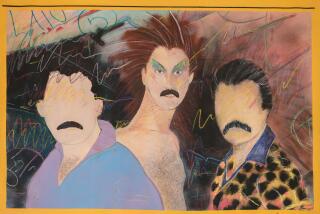Keeping Che Alive -- With Capitalism
- Share via
Ten years ago, in Havana, while researching a biography of Che Guevara, I asked his widow, Aleida March de Guevara, how she felt about communist Cuba’s rampant merchandising of her late husband. I pointed out how, in the tourist shops around the island, there were T-shirts, coconut shells and key rings with Che’s iconic image on them, all sold for Yankee dollars. Wasn’t this a betrayal of everything that Che, the ultimate Marxist revolutionary, had stood for?
Aleida shifted uncomfortably in her seat and replied defensively that she did her best to keep the Che products from becoming too vulgar. Che’s face would never be seen, for instance, on an ashtray. And she told me she had recently intervened to stop a British entrepreneur from continuing production of a beer called Che Fruta. “Che didn’t even drink alcohol,” she added indignantly.
As the widow of Cuba’s ultimate revolutionary martyr, consecrated officially by Fidel Castro’s regime as a kind of latter-day saint to the cause of global socialism, Aleida was in the uncomfortable position of trying to safeguard his real-life legacy while simultaneously propagating his mythologized persona. At that time, Cuba was extremely hard pressed economically and struggling desperately to find ways to bring in hard currency. Castro had recently given the go-ahead to limited foreign investment in Cuba, allowed the U.S. dollar as legal tender and announced that tourism would replace sugar as the island’s economic backbone.
Paraphrasing Castro’s rationales for his abandonment of Cuba’s socialist economy, Aleida explained that in order to “safeguard” Cuban socialism, the country had to adapt to changed circumstances: “If we can get Che’s ideas across to a youngster from el capitalismo [Cuba’s official euphemism for most of the rest of the world] because he wants to wear a T-shirt with Che’s face on it, so be it.”
As part of her effort to revitalize Che’s legacy, Aleida had authorized the publication of “The Motorcycle Diaries.” It was one of several previously unpublished personal journals Che left with her when, in 1965, he left Cuba to lead guerrilla insurgencies elsewhere -- first in the Congo and then in Bolivia, where, in 1967, he was tracked down and killed. “The Motorcycle Diaries” (which director Walter Salles has made into a film, starring Gael Garcia Bernal and opening this week) is an account of young Argentine-born Ernesto Guevara’s on-the-road motorcycle journey through Latin America in the early 1950s with his friend, Alberto Granado.
Ernesto Guevara was a medical student, but an avid reader of philosophy as well, and he was anxious to do something large with his life. He fantasized about one day becoming a great medical researcher and finding a breakthrough cure for one of mankind’s endemic maladies. In order to make the trip he skipped his junior year of medical school in Buenos Aires. On their road trip, Guevara observed first-hand the disease-ridden conditions of Latin America’s peasants. With growing indignation, he began to conclude that political injustice was the root cause of all evil.
A year later, diploma in hand, he set off on the road again, this time to Guatemala, where Latin America’s first socialist government had committed itself to sweeping land reform on behalf of the country’s indigenous peasants. Enthused by what he heard, and fired up with plans of becoming a “revolutionary doctor,” he arrived just in time to witness the CIA-sponsored overthrow of the government.
The experience radicalized and embittered him, and he ended up in Mexico, having concluded that “the Yankees,” as he said later, were “the enemies of humanity.” By 1955, he had found the source of mankind’s maladies, and the antidote, as he saw it, was Marxist revolution, achieved through armed guerrilla warfare. Soon after, he met exiled Cuban revolutionary Fidel Castro, joined his campaign to oust dictator Fulgencio Batista and became “Che.”
The inevitable wrangle over Che Guevara’s political legacy is ongoing, but his status as a cult figure has largely consigned such arguments to irrelevancy. Che’s symbolic appeal is global and wildly eclectic. His face can now be found on snowboards in Japan, on the mud flaps of trucks in Pakistan, on the flags of a soccer team in Italy and, in spite of his widow, on ashtrays in Cuba. Mike Tyson and Diego Maradona have had his face tattooed on their bodies. Not long ago, a Sunni cleric in Iraq quoted Che to me to justify Islamic jihad. In the anti-globalization protests that haunt every G-8 summit, Che’s image is prominent.
Something about Che’s life-and-death story, fused with the iconography of his graven image (as in the famous Korda portrait), has transcended, for better or worse, the actual substance of his life. As a brand, “Che” has been instinctively appropriated by a new generation for which his face itself stands as a potent symbol of youthful inconformity, of defiance of the status quo.
In a sense, as in the redemptive wall graffiti I observed in the Bolivian town where Che’s body was brought and exhibited, Christlike, after his execution -- “Che, alive, as they never wanted you to be” -- he lives on as a youthful recrimination of the Icarus myth, which is at once a moral tale and a lamentation about the eternal tragedy of the fleeting nature of youth and its doomed idealism. Of course, Che is also a modern re-embodiment of the ancient myth. Like Icarus, Che flew too close to the sun, and his wings melted.
More to Read
Sign up for Essential California
The most important California stories and recommendations in your inbox every morning.
You may occasionally receive promotional content from the Los Angeles Times.










